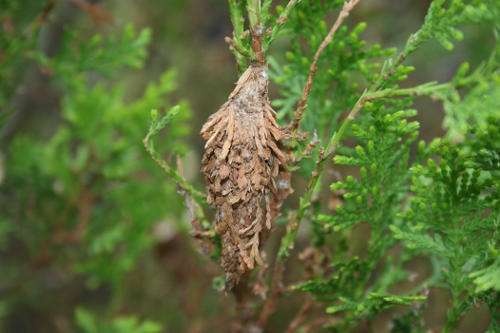Experts say treatment could last 4-5 weeks
MANHATTAN, Kan. – State forestry and horticulture experts are urging patience and persistence when trying to control bagworms, noting that multiple hatches of the caterpillars may emerge through late spring and early summer, depending on weather conditions.
Ryan Armbrust, forest health coordinator with the Kansas Forest Service, and Raymond Cloyd, extension specialist in horticultural entomology with K-State Research and Extension, advise that homeowners should scout for bagworms now and begin planning for treatment.
Once bagworms are spotted, they said, tree owners should plan to treat weekly for 4 to 5 weeks.
Cloyd said that in addition to multiple hatches over time, young bagworms can ‘blow in’ – called ‘ballooning’ – from neighboring plants on silken threads, increasing the importance of treating multiple times during the season.
“Once the larvae emerge, they begin feeding on the host tree or shrub as they work to build the encasing bag from which they take their name,” Armbrust said. “The plant debris bag provides protection for the bagworms and makes chemical treatment less effective.”
Armbrust said bagworms are ‘generalist’ insects, feeding on both conifers and deciduous trees. While defoliation of deciduous trees typically does not affect the long-term health of the tree, extreme defoliation of conifers can severely stress the tree or kill it outright.
He said chemical control of bagworms can be effective in preventing tree damage, but it is important to remember that the insect plays a role in the local ecosystem, providing a food source for many birds. Infestations are often cyclical, giving damaged trees the time they need to recover, so chemical treatment may not be required for many trees.
Armbrust advises chemically treating high-value conifers, such as those in windbreaks, Christmas tree farms, and ornamental landscape trees.
“Adequate coverage is especially important when treating for bagworms, including the penetration of the interior canopy and upper branches,” he said. “Commercial treatment may be more effective for larger trees or established windbreaks where common household sprayers do not have enough pressure to reach.”
Many insecticides are labeled to control bagworms, but timing and coverage must be carefully planned to ensure effectiveness. When caterpillars are small, the organic selective insecticides Bt (Bacillus thuringiensis, subspecies kurstaki) or spinosad can be effective.
Armbrust said these insecticides do not impact beneficial insects like broad-spectrum options, which sometimes lead to resurgent populations of spider mites that further damage treated trees.
However, if the early window for treatment is missed, broad-spectrum insecticides containing malathion, carbaryl, acephate, or cyfluthrin may be better options.
Hand picking and destroying bag worms once they construct their protective bags is also a great option for smaller infestations.
For more information on controlling bagworms, reference the publication, Bagworm: Insect Pest of Trees and Shrubs, written by Cloyd.
FOR PRINT PUBLICATIONS: Links used in this story
Kansas Forest Service, www.kansasforests.org
Bagworm: Insect Pest of Trees and Shrubs (Publication), https://bookstore.ksre.ksu.edu/pubs/MF3474.pdf
About the Kansas Forest Service
The Kansas Forest Service is the nation’s fifth oldest state forestry agency. The agency serves rural landowners, communities, rural fire districts, forest and arboriculture industries, and citizens of the state through its Conservation Tree and Shrub Planting, Fire Management, Community Forestry, Rural Forestry, Marketing and Utilization, and Forest Health programs. The Kansas Forest Service state office is located in Manhattan, Kansas, just west of the campus of Kansas State University. The Kansas Forest Service is housed as an independent agency within K-State Research and Extension. The agency receives its direction from a mission statement that reads: “Care of natural resources and service to people through forestry.”
About K-State Research and Extension
K State Research and Extension is a short name for the Kansas State University Agricultural Experiment Station and Cooperative Extension Service, a program designed to generate and distribute useful knowledge for the well being of Kansans. Supported by county, state, federal and private funds, the program has county extension offices, experiment fields, area extension offices and regional research centers statewide. Its headquarters is on the K State campus in Manhattan. For more information, visit www.ksre.ksu.edu. K-State Research and Extension is an equal opportunity provider and employer.
For more information:
Ryan Armbrust
785-532-3276
[email protected]





